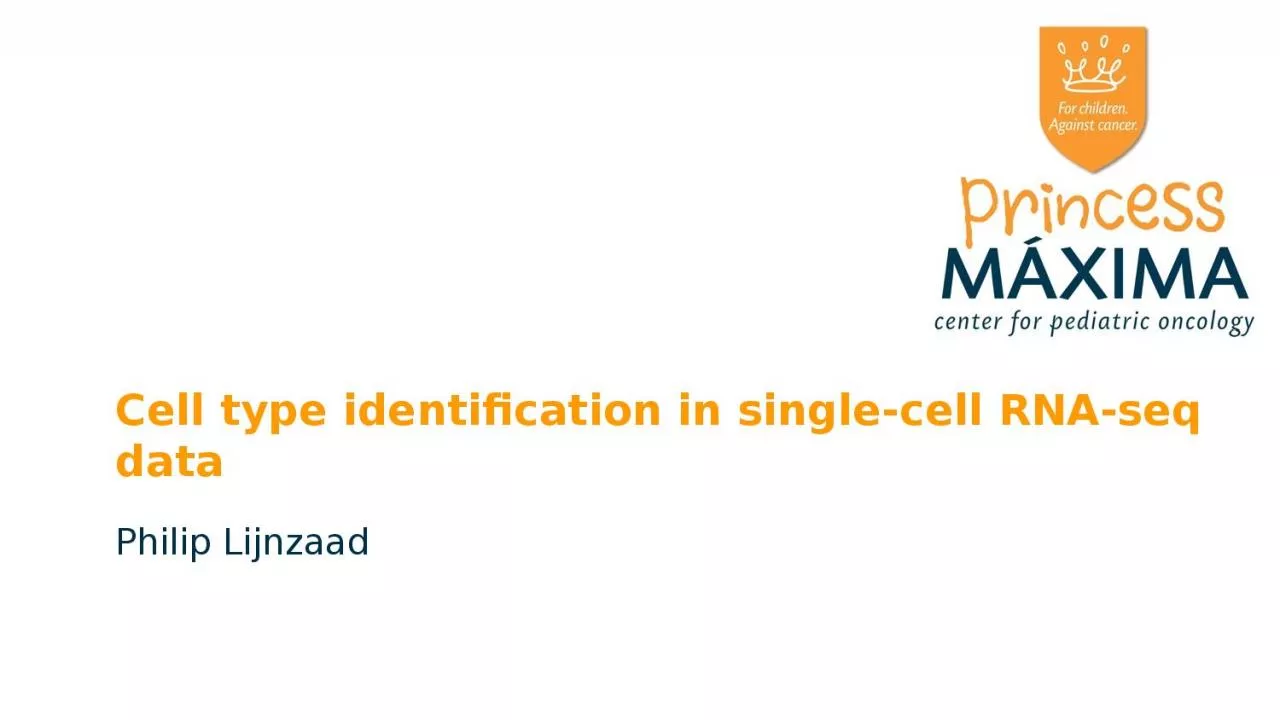

seq data Philip Lijnzaad Overview Introduction Manual methods Existing methods SingleR CHETAH Definition of cell type Originally defined in terms of tissue function and cell morphology ID: 998637
Download Presentation The PPT/PDF document "Cell type identification in single-cell ..." is the property of its rightful owner. Permission is granted to download and print the materials on this web site for personal, non-commercial use only, and to display it on your personal computer provided you do not modify the materials and that you retain all copyright notices contained in the materials. By downloading content from our website, you accept the terms of this agreement.
1. Cell type identification in single-cell RNA-seq dataPhilip Lijnzaad
2. OverviewIntroductionManual methodsExisting methodsSingleRCHETAH
3. Definition of cell type?Originally defined in terms of (tissue) function and cell morphology later extended presence/absence of Cell Surface markers gene expressionCurrently very much less fixed cell cycle phase migration state differentiation: cell stateMuch more fluid than it was, perhaps impossible to define
4. Cell type identification: why?Samples often heterogeneous Especially true for tumor samples‘Make sense’ of your dataFind new cell types
5. Cell surface markersOften considered the gold standard (esp. in immunology)mRNA of cell surface markers often lowly expressed or absent!Use combination of such marker genes, and also use different genes
6. Manual classificationTime-consumingRequires expert knowledgeLikely subjective and/or inaccurate
7. Automatic methodsUse complete cell type-specific mRNA expression profiles based on bulk RNAseq from FACS-sorted ’pure’ populations OR: manually curated cells picked from scRNA-seq data sets’the reference’Variety of approaches: methods: ad hoc, machine learning assign per individual cell, or per cluster of cellsAll use similarity to the reference, often based on correlation
8. Tumor cells are very diverseTirosh et al. 2016
9. Identifying tumor cellsComparing to tumor cell line expression does not workExpression often similar to fibroblastsSometimes possible to detect copy-number variations in scRNA-seq dataIdentify them by exclusion?
10. CNV detection in scRNA-seq data inferCNV tool(Patel et al. 2014)
11. Methodsscmap (Kiselev et al., Nature Meth. 2018)CaSTLe (Lieberman et al., PLoS ONE 2018)MOANA (Wagner & Yanai., BioRxiv 2018)SingleR (Aran et al., Nature Immun. 2019)SuperCT (Xie et al., NAR 2019)CHETAH (de Kanter et al., BioRxiv 2019, under review)...
12. De Kanter et al., under review
13. SingleRVery rich reference data: HPCA: hand-annotated Human Primary Cell Atlas 37 main types, 157 subtypes, 713 samples BluePrint + ENCODE 24 main types, 43 subtypes, 259 bulk RNAseq samples Mouse: ImmGen and ‘mouse.rnaseq’ (brain-specific)Classifies to both main and subtypes, and both single cell-wise and cluster-wise
14. SingleR methodCorrelate each cell (or average of cluster) to each sample← one cell← each dot is one reference sampleMain types →
15. SingleR methodPer cell type, correlate using the top N genes that have median(expression) > median(expression) in all other cell typesSingleR score per cell type is the 80%-ile of the correlationsFine-tuning: All types with score < (topscore – 0.05) are removed (if none, the worst is) Redo correlations (top N genes will differ) until one cell type remains N increases with decreasing number of remaining cell types
16. ← subtypes
17.
18.
19. CHETAHClassify cells by shunting cells down a hierarchy of cell typesAssign the most specific type you have evidence forAllow intermediate cell typesEvidence expressed as confidence scoreuses rank-based similarities called profile scoresrequires single-cell RNA-seq data as a referenceBioconductor, BioRxiv, github.com/jdekanter/CHETAH/
20. Tree of reference profilesExample of actual tree
21. Cell shuntingAt each branch point:Calculation of scoresAssignment of cellsRight, left, stopNext branch point
22. Cell shuntingAt each node:Calculation of scoresAssignment of cellsRight, left, stopNext node
23. Cell shuntingAt each node:Calculation of scoresAssignment of cellsRight, left, stopNext node
24. Cell shuntingAt each node:Calculation of scoresAssignment of cellsRight, left, stopNext node
25. Donet_SNE_1t_SNE_2CHETAH: CHaracterization of cEll Types Aided by Hierarchical clustering
26. Details← ? →
27. Profile scoreCorrelation (Spearman) is over the 200 genes with maximal DE between current type and the average of types in ‘the other branch’
28. Confidence score
29. First resultsCHETAHPublicationTirosh et al. 2016
30. Neuroblastoma data (Kholossy & Molenaar)colored by single-cell CNV score
31. Cell types not present in the referenceAdrenal cortex cellsSchwann cells
32. Acinar – ductal gradient in pancreas dataBaron et al. 2016; Muraro et al. 2016
33. Expression of ductal and acinar markers
34.
35.
36.
37. Genes used per node and cell-type
38. Thanks!Jurrian de KanterTito CandelliThanasis MargaritisFrank HolstegePatrick KemmerenWaleed KholosyJan Molenaar